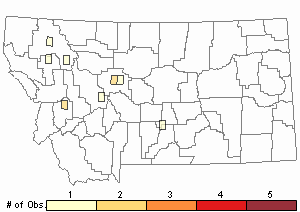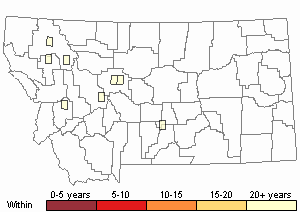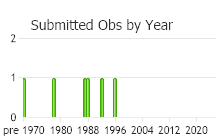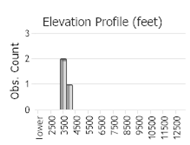View in other NatureServe Network Field Guides
NatureServe
Montana
Utah
Wyoming
Idaho
Wisconsin
British Columbia
South Carolina
Yukon
California
New York
A Lime Moss - Didymodon tophaceus
General Description
Plants: Acrocarpous, growing in open to crowded clumps of erect shoots, russet (Crum & Anderson et al., 1981), green to olivaceous, or pale yellow-brown, frequently lime-encrusted (FNA 2007). Stems 4-40 mm in height (Crum & Anderson et al., 1981), possessing a central strand; hairs of the leaf axil about 5 cells long, the first 1 or 2 cells brown (FNA 2007).
Leaves: Sometimes a little bent or twisted (Lawton 1971) and spreading a little (seldom flat against the stem) when dry, spreading and frequently keeled when damp, 1-2 mm in length (FNA 2007), those near the top of fertile stems typically larger (Crum & Anderson et al., 1981), egg-shaped, sometimes tending toward lance-shaped, or somewhat oblong (FNA 2007) or tongue-shaped (Lawton 1971), narrowing to a nearly obtuse to curved, obtuse apex, the apex not easily broken, widely grooved along the nerve; base egg-shaped and frequently extending along the stem (FNA 2007) 5-10 cells down (Lawton 1971); margins smooth, curved back and downward to above mid-leaf; costa extending to or ending slightly before the leaf tip, seldom forked distally, frequently red (FNA 2007) or brown (Crum & Anderson et al., 1981).
Leaf Cells: Upper laminal cells arranged in 1 cell-layer, isodiametric, typically smooth, occasionally with 1-2 papillae per lumen; lower laminal cells square or very slightly lengthened longitudinally; costa with somewhat long ventral cells in the middle rows or beyond, in X-section with 1 row (FNA 2007) of 3-8 guide cells, and 2 stereid bands, the ventral band smaller (Lawton 1971).
Phenology
Fruit ripens winter to spring (FNA 2007).
Diagnostic Characteristics
Didymodon nicholsonii, a western species, is also water-loving and has similarly-shaped leaves. However, its leaf margins or patches thereof, and occasionally the entire distal leaf lamina, are 2 cell-layers thick. In D. tophaceus, they are only of 1 cell-layer (FNA 2007).
Range Comments
North American Range
Canada: YT and NT, BC and AB, ON and QC; USA: most continental states except states east and north of NY and south of TN and VA; Mexico (FNA 2007). Known in Montana from Cascade, Flathead, Glacier, Lake, Lewis and Clark, Mineral, Missoula, and Stillwater Counties (Elliott & Pipp, 2016).
Observations in Montana Natural Heritage Program Database
Number of Observations: 10
(Click on the following maps and charts to see full sized version)
Map Help and Descriptions
Relative Density

Recency



 (Observations spanning multiple months or years are excluded from time charts)
(Observations spanning multiple months or years are excluded from time charts)
Habitat
Damp to wet, typically calcareous soil or stone, such as seeping bluffs (Crum & Anderson et al., 1981) and waterfalls. Elevation: 0-6560 feet (FNA 2007).
Reproductive Characteristics
Dioicous. Perichaetia occurring at the stem apices (FNA 2007). Perigonia growing at the stem apices or laterally (Lawton 1971). Seta red (Crum & Anderson et al., 1981), 7-12 mm tall. Capsule 0.6-1.5 mm in length; peristome with 16 very slender teeth split nearly to their bottom and not spiraled, or teeth short or lacking (FNA 2007), ochre, sometimes with a reddish tinge, thickly papillose (Crum & Anderson et al., 1981).
No specialized vegetative reproduction (FNA 2007).
Stewardship Responsibility
References
- Literature Cited AboveLegend:
 View Online Publication
View Online Publication Crum, H.A. and L.E. Anderson. 1981. Mosses of Eastern North America. 2 volumes. Columbia University Press, New York. 1328 pp.
Crum, H.A. and L.E. Anderson. 1981. Mosses of Eastern North America. 2 volumes. Columbia University Press, New York. 1328 pp. Elliott, J.C. and A.K. Pipp. 2018. A Checklist of Montana Mosses (1880-2018). Updated 3 January, 2020. Montana Natural Heritage Program, Helena, Montana. 73 pp.
Elliott, J.C. and A.K. Pipp. 2018. A Checklist of Montana Mosses (1880-2018). Updated 3 January, 2020. Montana Natural Heritage Program, Helena, Montana. 73 pp. Flora of North America Editorial Committee, eds. 2007. Flora of North America North of Mexico. Volume 27. Bryophytes: Mosses, Part 1. Oxford University Press, Inc., NY. xxi + 713 pp.
Flora of North America Editorial Committee, eds. 2007. Flora of North America North of Mexico. Volume 27. Bryophytes: Mosses, Part 1. Oxford University Press, Inc., NY. xxi + 713 pp. Lawton, E. 1971. Moss Flora of the Pacific Northwest. Hattori Botanical Laboratory. Japan: Yamabuki-cho, Shinjuku-ku, Tokyo. 362 pages plus appendices.
Lawton, E. 1971. Moss Flora of the Pacific Northwest. Hattori Botanical Laboratory. Japan: Yamabuki-cho, Shinjuku-ku, Tokyo. 362 pages plus appendices.
- Additional ReferencesLegend:
 View Online Publication
View Online Publication
Do you know of a citation we're missing? Elliot, J. C. 1993. Second checklist of Montana mosses. Unpublished report. U.S. Forest Service, Region 1. Missoula, MT. 45 pp.
Elliot, J. C. 1993. Second checklist of Montana mosses. Unpublished report. U.S. Forest Service, Region 1. Missoula, MT. 45 pp. Flowers, S. 1973. Mosses: Utah and the West. Brigham Young University, Provo, Utah. 567 p.
Flowers, S. 1973. Mosses: Utah and the West. Brigham Young University, Provo, Utah. 567 p. Lawton, E. 1971. Keys for the Identification of the Mosses on the Pacific Northwest. Reprinted from 'Moss Flora of the Pacific Northwest'. Published as Supplement No. 2 of the Journal of the Hattori Botanical Laboratory. Nichinan, Miyazaki, Japan. 66 pp.
Lawton, E. 1971. Keys for the Identification of the Mosses on the Pacific Northwest. Reprinted from 'Moss Flora of the Pacific Northwest'. Published as Supplement No. 2 of the Journal of the Hattori Botanical Laboratory. Nichinan, Miyazaki, Japan. 66 pp. Malcolm, B., N. Malcolm, J. Shevock, and D. Norris. 2009. California Mosses. Nelson, New Zealand: Micro-Optics Press. 430 pp.
Malcolm, B., N. Malcolm, J. Shevock, and D. Norris. 2009. California Mosses. Nelson, New Zealand: Micro-Optics Press. 430 pp. Smith, A.J.E. 1980. The Moss Flora of Britain and Ireland. Cambridge University Press, Cambridge. 705 pp.
Smith, A.J.E. 1980. The Moss Flora of Britain and Ireland. Cambridge University Press, Cambridge. 705 pp.
- Web Search Engines for Articles on "A Lime Moss"





